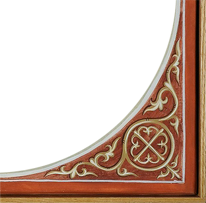Cine era Sfântul Andrei, "cel întâi chemat" la apostolie? Era frate al lui Simon Petru, care s-a numărat, de asemenea, printre cei 12 apostoli ai Domnului, fiind amândoi fiii pescarului Iona. Erau originari din Bersaida, localitate situată pe ţărmul Lacului Ghenizaret (Marea Galileii), din provincia Galileea, în nordul Ţării Sfinte. Amândoi au fost pescari, alături de tatăl lor. Amândoi s-au numărat printre "ucenicii" Sfântului Ioan Botezătorul, ascultȃnd timp îndelungat predicile acestuia în pustiul Iordanului cu îndemnuri la pocăinţă şi proorocia despre venirea lui Mesia. De la acesta a auzit Andrei cuvintele "Iată Mielul lui Dumnezeu, Cel ce ridică păcatul lumii" (Ioan 1, 29). A fost şi el martor, alături de alți ucenici, la botezul Domnului și la cunoscuta convorbire dintre Iisus și Ioan, întărindu-se în convingerea că Acesta era Mesia cel prezis de prooroci.
În urma poruncii Domnului, de a vesti Evanghelia la toate neamurile, după pogorârea Duhului Sfânt şi întemeierea Bisericii creştine la Ierusalim, în ziua cincizecimii din anul 30, Sfinţii Apostoli şi apoi ucenicii lor, au început să predice noua învăţătură adusă în lume de Mântuitorul Iisus Hristos. Potrivit tradiţiei şi celor scrise de unii istorici şi teologi din primele veacuri creştine, Sfântul Apostol Andrei a fost primul propovăduitor al Evangheliei la geto-daci, în teritoriul dintre Dunăre şi Marea Neagră - cunoscut pe atunci sub numele de Scythia (Sciţia), dar şi în teritoriile de dincolo de Prut, în nordul Mării Negre.
Sfântul Apostol Andrei a plecat de la noi spre sud, trecând prin Tracia, a ajuns în Bizanţ (viitorul Constantinopol), iar de aici a trecut prin Macedonia şi Tesalia, ajungând până în oraşul Patras din Ahaia, deci în Grecia de azi. Acolo a suferit moarte martirică, fiind răstignit pe o cruce în formă de X (numită până azi "Crucea Sfântului Andrei"). Biserica primară a stabilit, încă de pe la sfârşitul secolui II, ca dată de prăznuire a pătimirii sale ziua de 30 noiembrie. Nu se cunoaşte anul martiriului său; unii istorici îl fixează în timpul persecuţiei împăratului Nero, prin anii 64-67, alţii mult mai târziu, pe la sfârşitul veacului "apostolic", în cursul persecuţiei împăratului Domiţian.
Sfântul Sinod al BOR a hotărȃt în 1995 ca numele Sfântului Andrei să fie înscris în calendarul bisericesc cu cruce roşie, iar în 1997 l-a proclamat "ocrotitorul României". Sfântul Sinod a hotărât recent ca ziua de 30 noiembrie să fie proclamată sărbătoare bisericească naţională.
Pr. Prof. Dr. Mircea Păcurariu,
"Sfinţi daco-români şi români", Iaşi, 1994, pag. 19-24
Mai multe despre Sfântul Andrei puteţi găsi aici!
The Gospels tell us that Andrew was the brother of Simon Peter, and that they were fishermen from Bethsaida; they also had a house at Capharnaum, as we hear that our Lord stayed there when he was preaching in the neighborhood. Andrew had been a disciple of St John the baptist, and it was John who pointed out our Lord to him with the words, 'This is the Lamb of God.' Andrew and another of John's disciples immediately followed our Lord, and Andrew thus has the distinction of being known as the first of the disciples. He brought his brother Simon Peter to our Lord, and they became his disciples; but it was not until our Lord formally called them while they were casting their nets in the sea of Galilee that they 'dropped their nets immediately and followed him,' leaving their families, their business and their possessions. It was at this time also that James and John were called, and Andrew appears with them and his brother at the head of the list of the twelve apostles. It was he who brought to our Lord the boy with the five barley loaves and two fishes at the feeding of the five thousand; and he and Philip told our Lord of the gentiles who had come asking if they might see him (John 12:20-22).
We have various accounts of the later life of St Andrew, but they are fragmentary and mainly not dependable. The Christian historian Eusebius tells us that he preached in Scythia. St Gregory Nazianzen says that he went to Epirus, St Jerome that he was in Achaia--and there seems a genuine tradition that he was indeed in Greece. The medieval tradition that he finally arrived at Constantinople and founded a church there is apparently unfounded; and the details of his martyrdom are equally uncertain. He is said to have incurred the enmity of the proconsul at Patras in Achaia, and to have been bound to a cross, where he remained two or three days preaching to the people who came to watch him, before he died.
The Holy Synod of the Romanian Orthodox Chirch decided, in 1995, that the name of St Andrew to be included in the church's calendar as a celebration and in 1997 proclaimed him "Patron Saint of Romania".
Recently the Holy Synod decided that the day of November 30th to be declared "National Church Day".


 St. Andrew Facebook Page
St. Andrew Facebook Page

